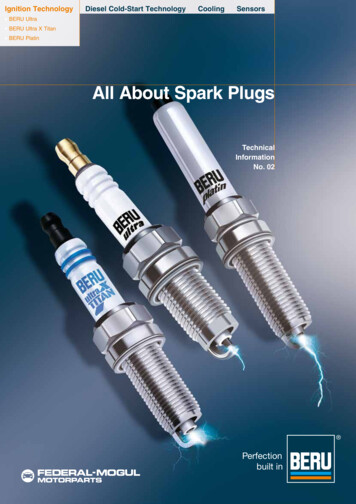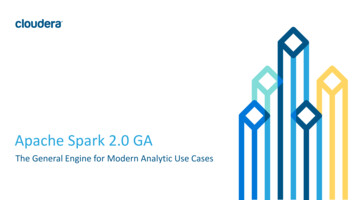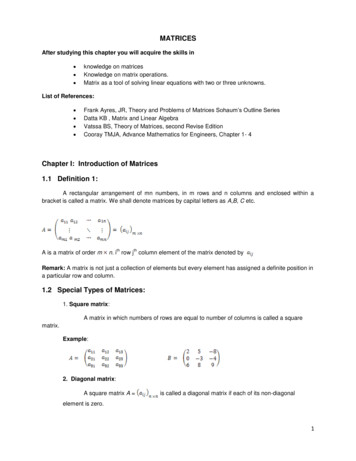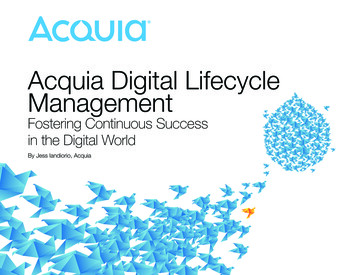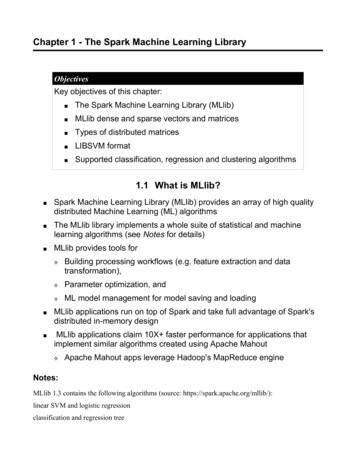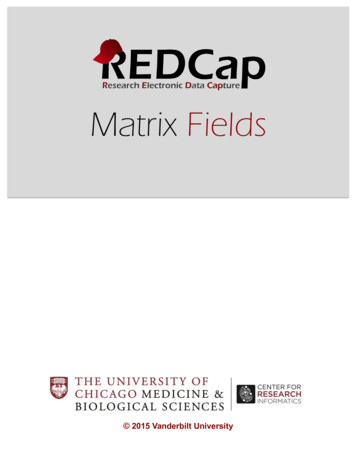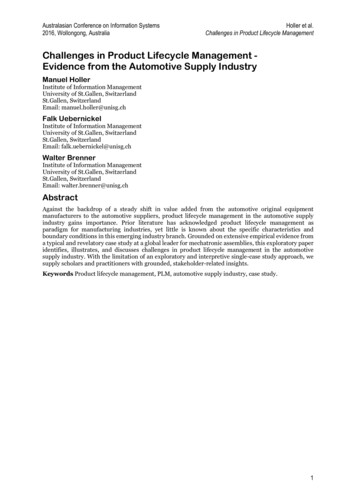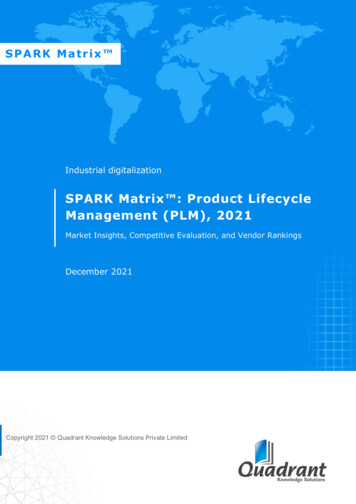
Transcription
SPARK Matrix Industrial digitalizationSPARK Matrix : Product LifecycleManagement (PLM), 2021Market Insights, Competitive Evaluation, and Vendor RankingsDecember 2021Copyright 2021 Quadrant Knowledge Solutions Private Limited
SPARK Matrix : Product Lifecycle Management(PLM), 2021Table of ContentsExecutive Overview . 3Key Research Findings . 3Market Overview and Technology Trends. 5Market Adoption Trend . 7Competitive Landscape and Analysis . 14Key Competitive Factors and Technology Differentiators . 14SPARK Matrix : Strategic Performance Assessment and Ranking . 18Vendor Profiles . 21Research Methodologies . 38Copyright 2021 Quadrant Knowledge Solutions Private LimitedFor Citation, info@quadrant-solutions.com2
SPARK Matrix : Product Lifecycle Management(PLM), 2021Executive OverviewThis research study includes a detailed analysis of the global Product LifecycleManagement (PLM) market dynamics, major trends, vendor landscape, andcompetitive positioning. The study provides competition analysis and ranking of theleading PLM vendors in the form of the SPARK Matrix. This research providesstrategic information for technology vendors to better understand the marketsupporting their growth strategies and for users to evaluate different vendors'capabilities, competitive differentiation, and market position.Key Research FindingsFollowings are the key research findings:Market Adoption TrendsDriven by the impact of Covid-19, the global economy, along with industries, is facingsignificant challenges and negative growth. Technology investments in 2020 havebeen significantly impacted due to the extended lockdowns imposed by globaleconomies around the world and continued uncertainty around Covid-19. While theindustrial companies were observing growth in 2021, the uncertainty around COVID19 remains there.Driven by the negative growth across industries, including automotive, industrialequipment, aerospace, high technology, and others, the global PLM market was umarounddigitaltransformation, the PLM market has grown by 5.2% in 2020 against forecasted marketgrowth of 7.8% by Quadrant's analysts in the PLM analysis conducted in 2019.Key Market Drivers Trends: Growing industrial digitalization, driven by the widespread adoption of IoTdevices and Industry 4.0 strategies Continued disruption in the industrial manufacturing technology landscape Increasing complexities of smart products, intelligent factories, and operationalprocesses PLM functionalities to support emerging technologies of the digital twin,additive manufacturing, virtual reality, and augmented reality Realizing the vision of Digital Twin and Digital Thread strategies The growing popularity of cloud-based PLM applicationCopyright 2021 Quadrant Knowledge Solutions Private LimitedFor Citation, info@quadrant-solutions.com3
SPARK Matrix : Product Lifecycle Management(PLM), 2021 Market expansion in mid-market and SMB sectors Global growth opportunities from process and batch manufacturing industriesCompetition Dynamics: PTC, Siemens and Dassault Systemes are the top performers and top threetechnology leaders in the global product lifecycle management market. Thesevendors provide a comprehensive technology portfolio with breadth and depthof design, simulation, product data management, innovation, and digitalmanufacturing solution sets. Aras and SAP are also positioned in the leadersection owning to their comprehensive PLM solution tightly integrated withbusiness systems, collaborative innovation, and analytics capabilities.Copyright 2021 Quadrant Knowledge Solutions Private LimitedFor Citation, info@quadrant-solutions.com4
SPARK Matrix : Product Lifecycle Management(PLM), 2021Market Overview and Technology TrendsProduct Lifecycle Management (PLM) consists of a set of software solutions to supportorganizations throughout the stages of the product lifecycles from itsconceptualization to its design, build, market, support, maintain, and retirement. Aholistic PLM solution supports enterprise-wide requirements for engineering designsand development, manufacturing workflows, and managing consistent productinformation. The solution enables collaboration amongst various internal and externalstakeholders responsible for specific product lifecycle processes.PLM is a mature and well-established technology strategy in managing productlifecycle from early concept generation through retirement. However, driven by amajor industry-wide transformation, due to the emergence of industrial digitalization,industry 4.0, and connected value chain initiatives, PLM vendors are adding advancedcapabilities incorporating emerging technology trends.Large manufacturing organizations are often associated with the large distributedecosystem of stakeholders and thereby face challenges in fostering effectivecollaborations amongst various distributed teams for managing product design anddevelopment processes. An inefficient system of managing product development datawith multiple disparate systems often results in extended time to market, developmenterrors, and poor product quality. While the majority of the large industrial companieshave adopted PLM technologies in managing design and development processes, themajority of these traditional solutions lack capabilities in handling present complexmarket dynamics. Additionally, traditional PLM solutions were associated with longimplementation, substantial upfront investment, difficulty to use, complex upgrades,and difficulty integrating with enterprise business systems.Large industrial companies are either amid digital transformation initiatives or planningtheir roadmap towards digitalization. Advanced PLM solution is considered a coretechnology platform for managing smart, connected, and complex productdevelopment processes in the digital age. Industrial companies are looking at PLMsolutions with key capabilities, including integrated data management, distributedcollaboration, and seamless integration with enterprise systems like manufacturingexecution systems (MES), enterprise resource planning (ERP), supply chainmanagement (SCM) and internet of things (IoT) platforms for a holistic strategytowards building a connected enterprise.Followings are the major components of a PLM solution: Multi-CAD Solution: Multi-CAD solution includes multiple applications for thedesign, analysis, and simulation of a product and production environment. Itincludes tools, such as computer-aided design (CAD), mechanical CADCopyright 2021 Quadrant Knowledge Solutions Private LimitedFor Citation, info@quadrant-solutions.com5
SPARK Matrix : Product Lifecycle Management(PLM), 2021(MCAD), electrical CAD (ECAD), computer-aided engineering (CAE),computer-aided manufacturing (CAM), electronic design automation (EDA),simulation & analysis, and others. Product Data Management (PDM): PDM platform includes a centralized andsecure product data repository that provides a single version of the truth andupdated product information to all the product stakeholders. Productinformation may consist of multi-CAD data, models, requirements, processinformation, documentation, and others. Advanced PDM platform includesrole-based access control to enable various product stakeholders to accessonly the relevant information to review, modify, comment, and share specificproduct information and features. Integrated PDM platform provides afoundation for a collaborative PLM environment to foster innovation andknowledge capture across organizational domains. Digital Manufacturing: Digital manufacturing solution includes integratedapplication suites to support the transition of product design intomanufacturing processes. It enables organizations to perform advancedmodelling, simulation and analysis of the manufacturing processes and plantenvironments, including layout, equipment, resources, assembly lines,material flow, and others. It helps manufacturing planning engineers to validateprocess design and optimize operational performance.Copyright 2021 Quadrant Knowledge Solutions Private LimitedFor Citation, info@quadrant-solutions.com6
SPARK Matrix : Product Lifecycle Management(PLM), 2021Market Adoption TrendDriven by the impact of Covid-19, the global economy, along with industries, is facingsignificant challenges and negative growth. Technology investments in 2020 havebeen significantly impacted due to the extended lockdowns imposed by globaleconomies around the world and continued uncertainty around Covid-19. While theindustrial companies were observing growth in 2021, the uncertainty around COVID19 remains there. Driven by the negative growth across industries, includingautomotive, industrial equipment, aerospace, high technology, and others, the globalPLM market was also negatively impacted. However, with continued momentumaround digital transformation, the PLM market has grown by 5.2% in 2020 againstforecasted market growth of 7.8% by Quadrant's analysts in the PLM analysisconducted in 2019.PLM vendors are making significant investments in adding advanced functionalities tohelp users achieve the next generation of connectivity performance improvements.Industrial companies are increasingly upgrading their traditional PLM solutions tosupport customer-centric product design and development approaches. The growingpopularity of 3d visualization, augmented reality, and the digital twin of product andproduction processes are gaining significant momentum from discrete manufacturingindustries to transform their end-to-end value chain processes.PLM value proposition in accelerating innovation, facilitating cross-functional globalcollaboration, improving product quality, and reducing time to market in the currentdynamic and competitive environment is well understood by organizations acrossindustry sectors. Thereby, PLM solutions are increasingly seen as a core technologysolution in designing and developing the next generation of smart connected productsand intelligent factories. The growing popularity of PLM functionalities to supportadvanced visualization, predictive analytics, additive manufacturing, and model-basedengineering and manufacturing are accelerating the adoption of advanced PLMsolutions across industry sectors. Additionally, the majority of the PLM vendors aremaking a significant investment in providing advanced PLM functionalities in realizingthe vision of an integrated and connected digital thread strategy. PLM vendorscontinue to focus on improving their technical capabilities and overall valueproposition in supporting organizations vision in realizing digital enterprise strategy.The global PLM market, which has grown by 5.2% in 2020, is expected to grow at aCAGR of 7.3% from 2021-to 2026. The global PLM market is expected to grow from 21.01 billion in 2020 to reach over 30.05 billion by 2026. In addition to the largecompanies from the traditional discrete manufacturing sectors, Global PLM vendorsare gaining significant greenfield market opportunities in the mid-market segmentsand emerging industries from process and batch manufacturing sectors.Copyright 2021 Quadrant Knowledge Solutions Private LimitedFor Citation, info@quadrant-solutions.com7
SPARK Matrix : Product Lifecycle Management(PLM), 2021On deployment type, the PLM market is primarily dominated by on-premisesdeployments. However, almost all major PLM vendors are focusing on improving theircloud PLM value proposition with subscription-based pricing. This trend is expectedto play a crucial role in improving the penetration rate in small and mid-sizedbusinesses (SMBs) and the overall market growth of PLM solutions during 2021-2026.Cloud PLM solution promises to reduce/eliminate the users' primary challengesrelated to implementation, customization, software upgrades, and higher licensingcosts. Regarding market trends, on-premises deployment is expected to remain apreferred choice, especially by large organizations from conventional industries.Copyright 2021 Quadrant Knowledge Solutions Private LimitedFor Citation, info@quadrant-solutions.com8
SPARK Matrix : Product Lifecycle Management(PLM), 2021Figure: Market Adoption TrendPLM market is expected to grow at a CAGR of 7.3% from 2021-to ht 2021 Quadrant Knowledge Solutions Private LimitedFor Citation, info@quadrant-solutions.com9
SPARK Matrix : Product Lifecycle Management(PLM), 2021PLM is Transforming to Become Product InnovationPlatformIndustrial companies are looking at a seamlessly integrated and collaborativeenterprise software platform to enable end-users to deploy multiple integratedapplications for managing product design and development, 3D modelling andanalysis, production, operations, and maintenance functions.PLM vendors are making a significant investment in building a product innovationplatform with the next generation of integration and interoperability capabilities tosupport a broad range of PLM-enabling applications enterprise and business systems.PLM vendors are focusing on building several out-of-the-box functionalities andapplications that can be deployed rapidly, leveraging an integrated product innovationplatform.PLM vendors may require creating a robust ecosystem of technology partners tosupport instant integration of a wide variety of applications and manage end-to-endprocesses of various product lifecycle stages. PLM vendors may also develop an openAPI-centric platform architecture to provide a collaborative environment fordevelopers to develop and share innovative applications.Growing Requirements for Next-Generation of MultiDisciplinary Development CapabilitiesDigital transformation trends are influencing industrial companies across verticals tofocus on building the next generation of smart products and intelligent factories.However, these smart connected products are highly complex in terms of built-inintelligence, connectivity, security, compliance requirements, and need to offeradvanced functionalities. Organizations face challenges developing complex productsand varieties across large, geographically distributed and multi-disciplinary teams.Organizations require an integrated design approach with enhanced collaborationbetween multiple disciplines, including mechanical, electrical, and software, todevelop the next generation of smart connected products. PLM vendors offeradvanced functionalities with multi-disciplinary development capability that enableproduct developers and manufacturing engineers to design, simulate, and validate thecomplex behavior of smart products and intelligent production systems early in theproduct lifecycle. This significantly reduces the time and costs of design, specification,and validation of complex products, processes, and systems. Additionally, it is creatingadditional revenue for PLM vendors in addressing the complexities of smart productsand processes across industry segments. PLM vendors are also strengthening theircapabilities to develop and maintain digital twin and digital thread of end-to-endprocesses.Copyright 2021 Quadrant Knowledge Solutions Private LimitedFor Citation, info@quadrant-solutions.com10
SPARK Matrix : Product Lifecycle Management(PLM), 2021Digital Twin and Digital Thread Use Cases are GainingSignificant MomentumA digital twin is a comprehensive digital representation of the physical products,processes, and systems in a virtual 3D environment. Digital twins are used as aninformation and behavioral model to understand, simulate, predict, and optimize theperformance of a product and production system. Digital twin captures all the changesthat occur throughout the product lifecycle stages from concept generation throughdevelopment, manufacturing, and service, creating a consistent digital thread.Leveraging an integrated PDM platform, PLM vendors enable creating andmaintaining a digital thread with up to date and synchronized information throughoutthe product lifecycle.Digital transformation trends across industries are driving the next generation ofperformance improvements from product design and development to itsmanufacturing and supply chain. Digital twin use cases for product design &development, advanced modelling & visualization, simulation of product andproduction environment, and such others are getting established to drive the nextgeneration of performance improvements. End users from automotive, aerospace,industrial machinery and others are leading the adoption of digital twin technologies.Leading PLM vendors are further augmenting the capabilities to support digital twinand digital thread by leveraging advanced simulation, predictive analytics, andmachine learning capabilities. Additionally, PLM vendors are investing in developingcompelling use cases across product design & development, manufacturing process,performance monitoring, maintenance, and creating and maintaining a digital threadwith synchronized information throughout the product lifecycle stages.Emerging Technologies, including Additive Manufacturing,VR, and AR, are Augmenting the PLM CapabilitiesPLM vendors have made significant strides in including capabilities to supportemerging technologies that may influence product development processes. PLMvendors are actively adopting mergers, acquisitions, and partnership strategies tosupport users in providing functionalities to support emerging technologies such asadditive manufacturing, virtual reality (VR), and augmented reality (AR).PLM vendors are integrating additive engineering and manufacturing capabilities intheir offerings to support the organization's smart manufacturing initiatives. Severalindustries, including aerospace & defense, industrial equipment, automotive, andothers, are increasingly adopting additive manufacturing technologies to printcomplex component parts that otherwise require complex machining. This helps ineliminating tooling costs for obsolete service parts.Copyright 2021 Quadrant Knowledge Solutions Private LimitedFor Citation, info@quadrant-solutions.com11
SPARK Matrix : Product Lifecycle Management(PLM), 2021PLM vendors continue to improve the capabilities of offering virtual and augmentedreality devices and applications to provide their customers with an edge overcompetitors in bringing innovative products faster in the market. Organizations areincreasingly using VR/AR technologies to accelerate the processes of the entireproduct lifecycles. Virtual reality enables users to perform computer-generatedsimulations of product definitions, process design, inspection, and training. Whereasaugmented reality technologies are predominantly used in simulating assembly,production line, and service areas to improve the clarity of the process understanding,predict product behavior, improve product quality, and overall efficiency of themanufacturing operations.AR/VR technologies provide a competitive advantage as they enable digital twin anddigital threads in an immersive virtual environment to significantly improve operationalefficiency and reduce time to market.Integration of IoT Analytics into PLM Platforms isBecoming a Key DifferentiatorIn the age of Industry 4.0, industrial companies are significantly adopting IoTtechnologies to drive the next generation of performance improvements. However,integration and interoperability of their technology infrastructure are essential tosecure the investments for long-term success. As IoT technologies are widely accepted amongst industrial manufacturing,energy & utilities, healthcare, retail, and transportation industries, PLMvendors are bringing product analytics capabilities of IoT technology into theirPLM solutions. PLM vendors are increasingly integrating their PLM solutionswith IoT platforms. This enables organizations to connect real-time product'soperational data into PLM platforms to gain insights into how products areperforming in the field, thereby optimizing their usability, quality, maintenance,and service performance. PLM solution with integrated IoT platform capability provides end-to-endperspectives of the product lifecycle. IoT capability is becoming an importantdifferentiator for PLM selection in the age of smart manufacturing and Industry4.0. By integrating its industry-leading ThingWorx capability into its Creo CADsoftware and Windchill PLM application suite, PTC has taken an early lead andis gaining significant market traction. Siemens PLM is also integrating itsMindSphere IoT platform and other application suites to drive the nextgeneration of connectivity and performance improvements. DassaultSystemes continue to improve its 3DEXPERIENCE platform capabilities tosupport the internet of experience for digitally connected products, nature, andlife in the physical world.Copyright 2021 Quadrant Knowledge Solutions Private LimitedFor Citation, info@quadrant-solutions.com12
SPARK Matrix : Product Lifecycle Management(PLM), 2021 The integrated PLM and IIoT platform approach is amongst the primary marketdrivers and contributes to the growth of the overall PLM and IIoT platformsmarket.Copyright 2021 Quadrant Knowledge Solutions Private LimitedFor Citation, info@quadrant-solutions.com13
SPARK Matrix : Product Lifecycle Management(PLM), 2021Competitive Landscape and AnalysisQuadrant Knowledge Solutions analyzed major product lifecycle managementvendors in-depth by evaluating their products, market presence, and valueproposition. The evaluation is based on primary research with expert interviews,analysis of use cases, and Quadrant's internal analysis of the overall PLM market. Thisstudy includes an analysis of 7 key vendors, including Aras, Autodesk, DassaultSystemes, Oracle, PTC, SAP, and Siemens.PTC, Siemens and Dassault Systemes are the top performers and top threetechnology leaders in the global product lifecycle management market. Thesevendors provide a comprehensive technology portfolio with breadth and depth ofdesign, simulation, product data management, innovation, and digital manufacturingsolution sets. These vendors are also frontrunners in integrating advanced analytics,3D visualization, advanced analytics powered by artificial intelligence and machinelearning, IoT analytics, additive manufacturing, augmented reality (AR), and otherinnovative technologies in their PLM solution portfolio. Aras and SAP is also positionedin the leader section owning to their comprehensive PLM solution tightly integratedwith business systems, collaborative innovation, and analytics capabilities.Key Competitive Factors and TechnologyDifferentiatorsFollowings are the key competitive factors and differentiators for evaluating PLMsolutions and vendors. While the majority of the PLM vendors may provide all the corefunctionalities, the breadth and depth of the capabilities may differ by different vendorsofferings. Some key differentiators include ease of deployment and ownershipexperience, the sophistication of integrated BOM management, model-basedenterprise strategy with digital twin and digital thread technologies, out-of-the-boxapplications, technology integration & interoperability, advanced analytics, and others. The Sophistication of Integrated BOM Management: Organizations arefacing challenges in maintaining consistent product data throughout theirproduct lifecycle. Traditionally, manufacturing planning personnel often modifyengineering BOM with manufacturing-specific information to create a newrecord as manufacturing BOM. This has resulted in increased complexities ofBOM management. Additionally, growing product varieties and multiplecontent authoring by various teams across departments and geographicallocations further add to the complexities. Organizations are looking at buildinga unified BOM by synchronizing and integrating engineering BOM tomanufacturing BOM to ensure a consistent product definition through design,development, manufacturing, and service. Major PLM solution providesCopyright 2021 Quadrant Knowledge Solutions Private LimitedFor Citation, info@quadrant-solutions.com14
SPARK Matrix : Product Lifecycle Management(PLM), 2021capabilities of integrated BOM management with a single centralized sourcefor all product information across the organization departments and externalstakeholders. PLM solutions are also integrated with enterprise systems,including MES and ERP, to manage consistent BOM information acrosssystems and enable efficient execution of product lifecycle processes. Thishelps organizations in maintaining a consistent product definition with closedloop lifecycle management from early concept development through actualproduct release and after-sales services. The sophistication of integrated BOMmanagement is amongst the essential value proposition and technologydifferentiator. Model-Based Enterprise Strategy with Digital Twin and Digital ThreadTechnologies: PLM vendors capabilities in providing a robust tool for creatinga digital twin of product and production processes are essential to helpindustrial companies in realizing their digital transformation roadmap. Digitaltwins are used as an information and behavioral model to understand,simulate, predict, and optimize the performance of a product and productionsystem. Digital twin captures all the changes throughout the product lifecyclestages from concept generation through development, manufacturing, andservice, creating a consistent digital thread. Leveraging an integrated PDMplatform, PLM vendors enable creating and maintaining a digital thread withup to date and synchronized information throughout the product lifecycle.Digital thread facilitates collaboration between product engineering withmanufacturing engineering for creating a consistent 3D model integrated witha digital twin of products and production processes. While leading PLMvendors support model-based engineering with digital twin and digital threadstrategies, the effectiveness of the solution capabilities may differ betweenvendors solutions. Out-of-the-Box Applications and Functionalities: While PLM is considereda mature solution, it still requires significant customization resulting in a longimplementation cycle, increased costs, and reduced agility to cope with thefuture business transformation. The configurable and out-of-the-boxapplication promises to significantly reduce/eliminate customization whileenabling configuration to meet organization-specific needs. The majority of thePLM vendors are focusing on offering several out-of-the-box functionalitiesincorporating customers best practices and industry collaborations tosignificantly reduce implementation costs and improve time to market.However, the PLM industry is still striving to balance customization versus outof-the-box functionalities. Quadrant Knowledge Solutions believes that thenext generation of PLM evolution with comprehensive and proven out-of-thebox solutions is expected to drive significant technology adoption and marketCopyright 2021 Quadrant Knowledge Solutions Private LimitedFor Citation, info@quadrant-solutions.com15
SPARK Matrix : Product Lifecycle Management(PLM), dorswithcomprehensive, proven, and industry-specific out-of-the-box functionalities toaccelerate the deployment process and overall technology ownershipexperience. Technology Integration and Interoperability: The scope of the PLM solutionhas expanded from the traditional focus on just design and build processes toinclude integrated data management and execution of product developmentprocesses from concept generation to its retirement within a distributedcollaboration framework. PLM capability in providing seamless integration ofxCAD with PLM solutions and enterprise applications, including MES, ERP,CRM, SCM, HCM, and others, is an important differentiator to supportorganizations in unifying products and process data across domains andlocations. PLM vendors' capabilities may differ in providing system integrationand interoperability with upstream business systems and downstreamtechnologies. Deployment and Ownership Experience: Traditional on-premise PLMsolutions are associated with lengthy implementation, complex licensing andupgrades, and large upfront investment. PLM vendors are aggressivelyinvesting in building a robust cloud PLM capability to address implementationchallenges and target new markets. User organizations are increasinglyevaluating the value proposition and vendor's capability in providing singletenant or multi-tenant SaaS and hybrid PLM deployment. However, the PLMdeployments continue to be primarily dominated by on-premise deploymentby large industrial companies. The prime target for cloud-based deploymentremains the emerging market, non-traditional industries, and SMBorganizations. As the industrial companies continue to move towards theirconnected enterprise vision, cloud-based deployment is expected to findsignificant adoption by organizations across industry verticals. Additionally,PLM vendors continue to improve capabilities to suppor
63 5.0DWUL[w Product Lifecycle Management (PLM ), 202 1 Market Overview and Technology Trends Product Lifecycle Management (PLM) consists of a set of software solutions to support organizations throughout the stages of the product lifecycles from its con ceptualization to its design, build, market, support, maintain, and retirement.


